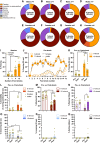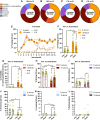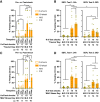Sex and estrous cycle effects on stress-enhanced fear learning in Long-Evans rats
- PMID: 40774804
- PMCID: PMC12419549
- DOI: 10.1101/lm.054097.125
Sex and estrous cycle effects on stress-enhanced fear learning in Long-Evans rats
Abstract
Individuals diagnosed with post-traumatic stress disorder (PTSD) are hyperresponsive to otherwise ordinary stimuli (e.g., loud noises or certain smells) long after a traumatic experience. At a preclinical level, this persistent effect of trauma is captured in stress-enhanced fear learning (SEFL), in which a stressful experience in one context causes a persistent increase in fear conditioning with a mild stressor in a second context. Here, we characterized multiple behaviors (including freezing, rearing, darting, and jumping) in male and female Long-Evans rats during SEFL. Rats received a battery of foot shocks in one context followed by a mild stressor (single foot shock) in a second context. We found that males and females with a history of multiple shocks in one context had higher freezing levels during the SEFL test, relative to no shock controls, and that this SEFL effect persisted to a second test 30 days later. The dominant response was freezing in males and females, with no reliable sex differences at any stage of the SEFL procedure, but females also showed some unique escape-like behaviors on the days of trauma and mild stress exposure. In addition, females in the proestrus and estrus phases of the estrous cycle during the initial shock exposure showed increased SEFL relative to females in the metestrus and diestrus phases. These findings suggest that males and females show similar SEFL effects with freezing behavior, but that ovarian cycle phase at the time of trauma may alter the strength of SEFL in females.
© 2025 Lopez-Kawa and Lattal; Published by Cold Spring Harbor Laboratory Press.
Figures





References
-
- American Psychiatric Association. 2022. Diagnostic and statistical manual of mental disorders: DSM-5-TR, 5th ed., text revision. American Psychiatric Association Publishing, Arlington, VA.
MeSH terms
Grants and funding
LinkOut - more resources
Full Text Sources
Medical
